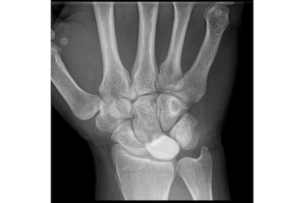KIENBÖCK’S DISEASE
If you suffer from painful and stiff wrist please Schedule an appointment with one of our orthopedic specialists as soon as possible

What is Kienböck’s Disease?
Kienböck’s disease, alternatively termed avascular necrosis of the lunate, impacts the wrist joint by interrupting the blood supply to the lunate bone, one of the small wrist bones. This interruption results in the gradual decay or demise of the bone over time.
The exact cause of Kienböck’s disease remains incompletely understood. However, it is thought to stem from a blend of factors, including trauma, anatomical variances, and diminished blood flow to the lunate bone. This condition typically afflicts individuals aged in their 20s to 40s and exhibits a higher incidence in men than in women.
Indication Of Kienböck’s Disease
The advancement of Kienböck’s disease generally encompasses multiple stages; nevertheless, it’s crucial to recognize that symptoms and stages can differ among individuals. If you encounter persistent wrist discomfort, swelling, or restricted wrist mobility, seeking medical assessment for accurate diagnosis and suitable treatment choices is recommended.
In the early stages (Stage I), mild or no symptoms may be present, and X-rays might not indicate significant changes. However, microscopic alterations in the blood supply to the lunate bone may already be occurring. Progressing to Stage II, the compromised blood supply causes bone tissue death, resulting in wrist pain, stiffness, and swelling, with X-rays potentially showing evidence of bone collapse or sclerosis. In Stage III, the lunate bone fragments and collapses further, intensifying pain, restricting wrist motion, and potentially leading to arthritis in neighboring joints. However, with X-rays typically revealing notable changes in bone structure.
Treatment For Kienböck’s Disease
The treatment for Kienböck’s disease depends on the stage of the condition and the severity of symptoms. Conservative treatments may include immobilization of the wrist with a splint or cast. Additionally, physicians may prescribe pain management with medications, and physical therapy to maintain wrist mobility and strength.
In more advanced cases, surgical interventions may be considered. These can range from procedures to reestablish blood supply to the lunate bone to procedures that aim to alter the alignment of the bones in the wrist joint to relieve pressure on the lunate bone.
The goal of treatment is to alleviate pain, restore wrist function, and prevent further deterioration of the lunate bone. Early diagnosis and treatment offer the best chances of successful outcomes in managing Kienböck’s disease. If you suspect you may have this condition, it is important to consult with a healthcare professional for an accurate diagnosis and appropriate treatment options.

